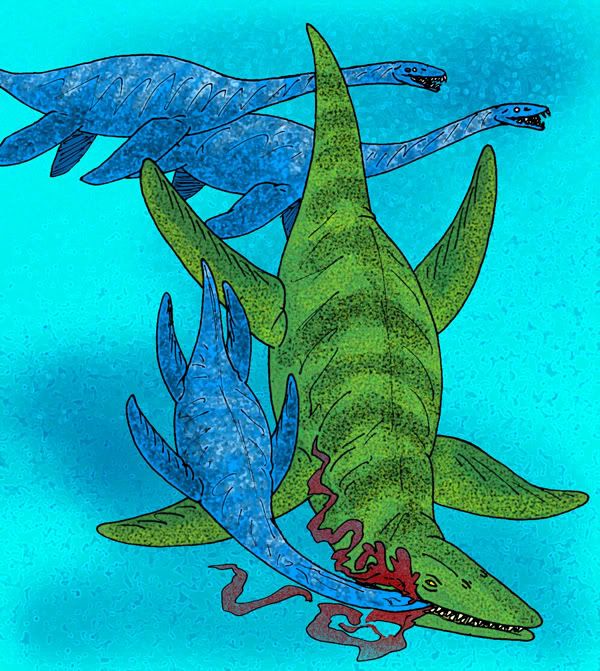Post by Barry the Baryonyx on Jul 8, 2007 21:21:29 GMT -5
Kronosaurus queenslandicus

(c) Stanton F. Fink
Kronosaurus (pronounced Kroe-noe-sore-uss) was one of the sea reptiles known as pliosaurs — a member of the plesiosaur group, but in the Pliosauridae family, with the distinctive feature of a much shorter, thicker neck. Pliosaurs were more heavily built, more streamlined, faster and fiercer than other plesiosaurs, and were suited to catch fewer, larger meals with their massive jaws and rows of sharp teeth up to 25 cm (10 inches) long. The huge head, which was mostly mouth, also had large eyes and an offset pair of nostrils that gave it directional "water-sniffing" ability, as in other plesiosaurs. A pliosaur swam with all of its four limbs, which had evolved into long, wide, strong flippers, one at each corner of the elongated body. The tail was short and tapering, as in other plesiosaurs, and was perhaps used only for steering.
Kronosaurus was one of the largest pliosaurs and lived in the Early Cretaceous Period. Most of its fossils are known from Australia, where they were first discovered in 1889 in Queensland, which was covered by shallow sea some 120 million years ago, though the most complete fossil to date was found in Villa de Leyva (Colombia) in 1977. The name was given in 1924 by Heber Longman. For many years, estimates put the total length of Kronosaurus at up to 13 meters (43 feet), but recent studies of its fossil skull and other parts, and comparisons with other pliosaurs, suggest that the true length was probably only 9–10 meters (30–33 feet). Other creatures preserved from the time include numerous fish and various molluscs such as squid, ammonites and belemnites. Some of their fossil shells bear tooth marks that could have been made by Kronosaurus, whose rear teeth were rounded and suited to crushing hard-cased victims.
The holotype specimen of the species K. queenslandicus was described by Longman in 1924, and is currently in the Queensland Museum. Hampe described a second species, K. boyacensis, in 1992 but the dubious state of the holotype specimen makes the assignment to the Kronosaurus genus uncertain.
It is named after the Greek Titan Kronos, who ate his own children, the Olympians.
The Kronosaurus is featured in the Steve Alten novel, "The Trench", although he has taken great creative liberties with them by presenting them as evolved versions of their prehistoric ancestors, living thousands of feet below sea level and having gills.
Copyright © 2007 Answers Corporation


 Is it just us?
Is it just us?